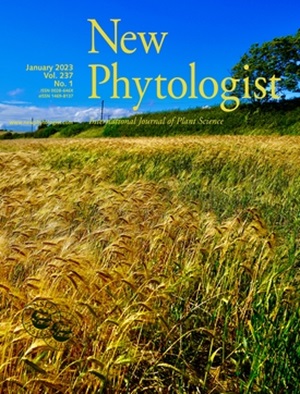OsNIP3;1介导水稻脉管顶端的硼昼夜振荡。
IF 8.1
1区 生物学
Q1 PLANT SCIENCES
引用次数: 0
摘要
植物外质体是保证某些矿物溶质正常发挥作用的重要隔室,而脉管系统则是在连续外质体的不同部分之间分配矿物溶质的长距离系统。起搏发生在脉管系统的远端,但它如何增加离子稳态却很少受到关注。通过对184份水稻核心材料的外质体液、管状液和木质部汁液进行基因组尺度的基因组分析,我们发现了新的基因组结构和动态。最独特的发现是硼浓度在叶片的远端跳跃到峰值水平。这种现象在其他植物中也存在。叶尖处的硼浓度随叶尖变化而变化。组织特异性基因表达分析显示,硼流入转运基因osnip31,1在叶尖突出,并与硼同步振荡。osnip31,1的破坏降低了硼振荡的幅度和[硼]断枝液/木质部汁液的比例。我们的研究结果表明,osnip31,1介导了断枝过程中叶片远端硼振荡。本文章由计算机程序翻译,如有差异,请以英文原文为准。
OsNIP3;1 mediates diurnal boron oscillation at rice vasculature tip
- Plant apoplast represents an essential compartment for the proper function of certain mineral solutes, and vasculature acts as a long-distance system to distribute them between different parts of the continuous apoplast. Guttation occurs at the distal end of the vasculature, but how it adds to ion homeostasis has received scant attention.
- Through genomic-scale ionomic profiling of apoplast fluids, guttation fluid, and xylem sap from 184 core accessions of paddy-grown rice, we identified novel ionomic constitution and dynamics. The most unique finding is that boron concentration jumps to a peak level at the distal end of the leaf blade. This phenomenon is conserved in other plants performing guttation. Boron concentration at leaf tips oscillates diurnally depending on guttation.
- Tissue-specific gene expression analysis revealed that the boron influx-transporter gene OsNIP3;1 is prominent in leaf tips and oscillates in synchronization with boron. Disruption of OsNIP3;1 decreased amplitudes of boron oscillation and the ratios of [Boron]guttation fluid/xylem sap.
- Our findings reveal that OsNIP3;1 mediates boron oscillation at the distal end of the leaf blade during guttation.
求助全文
通过发布文献求助,成功后即可免费获取论文全文。
去求助
来源期刊

New Phytologist
生物-植物科学
自引率
5.30%
发文量
728
期刊介绍:
New Phytologist is an international electronic journal published 24 times a year. It is owned by the New Phytologist Foundation, a non-profit-making charitable organization dedicated to promoting plant science. The journal publishes excellent, novel, rigorous, and timely research and scholarship in plant science and its applications. The articles cover topics in five sections: Physiology & Development, Environment, Interaction, Evolution, and Transformative Plant Biotechnology. These sections encompass intracellular processes, global environmental change, and encourage cross-disciplinary approaches. The journal recognizes the use of techniques from molecular and cell biology, functional genomics, modeling, and system-based approaches in plant science. Abstracting and Indexing Information for New Phytologist includes Academic Search, AgBiotech News & Information, Agroforestry Abstracts, Biochemistry & Biophysics Citation Index, Botanical Pesticides, CAB Abstracts®, Environment Index, Global Health, and Plant Breeding Abstracts, and others.
 求助内容:
求助内容: 应助结果提醒方式:
应助结果提醒方式:


